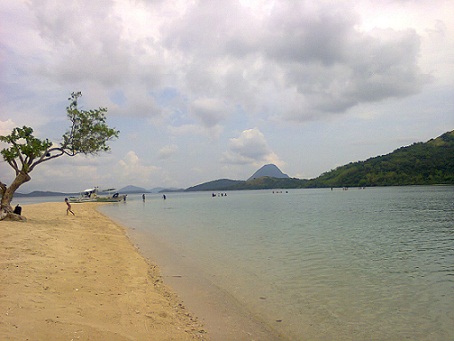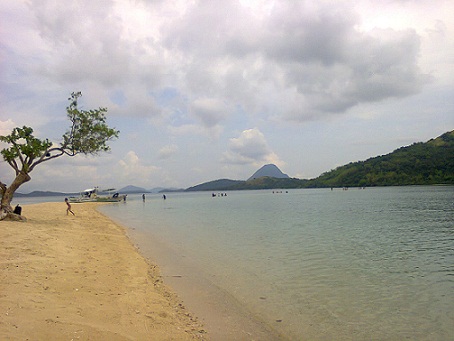Text and photos by HAZEL P. VILLA
HOW he ended up by his lonesome in a rice field somewhere in the heart of an island of white sand and jagged black rocks and cliffs was a mystery to then 12-year-old Daniel Villarias. There he found the barely moving baby sea hawk, which he christened Popoy.
Nursed by Daniel, Popoy soon started to fly, found a mate, and made Agho Island in the town of Concepcion in Iloilo province his home. Eleven years after, about 200 sea hawks locally called “dapay” could be seen flying around the island.
Visitors to the nine-hectare island could hear the screech of the sea hawks (also called fish eagle or fish hawk) at around 5 to 6 p.m. At low tide, some would perch on the rocks by the beach, hoping to catch some fish while others majestically glide above the island.
Popoy’s fine-feathered family is just one of the many unexpected attractions in Agho Island in the coastal town of Concepcion in northern Iloilo.
 The island is also a sanctuary for about 100 Tabon birds (or Tabon Scrubfowl) that lay over-sized eggs deep in loose sand or a mound of rotting vegetation. The local islanders describe the Tabon birds as looking like chickens but are heavier and can run faster.
The island is also a sanctuary for about 100 Tabon birds (or Tabon Scrubfowl) that lay over-sized eggs deep in loose sand or a mound of rotting vegetation. The local islanders describe the Tabon birds as looking like chickens but are heavier and can run faster.
Agho Island, which is a 30-minute pump boat ride from the mainland of Concepcion, is one of those “accidental resorts” that had no choice but to “develop” because of its increasing number of visitors every year– courtesy of YouTube and irrepressible travel bloggers.
“Development” can be seen in various forms— electricity produced by a generator, one big cottage with mezzanine that can house about 30 people at P1,500 a night, three mid-sized huts with their own makeshift kitchen at P700, and six open air huts at P100 each. And yes, there are three outdoor toilets with roofs and fresh water by the gallon all the way from nearby Malangabang Island.
This year, the island’s first and only sari-sari store opened and beside it an unforgivably loud sound system that blares Psy’s “Gangnam Style” and other such hits to remind visitors this is no hick island.
The island, which is home to the Villarias clan, is rich in stories about visits by Japanese soldiers during World War II, land disputes, and cocaine raids.
The Villarias patriarch, 82-year-old Cirilo narrates that in 1980, an American couple, Tomas and Terry Cork, arrived in Agho Island on the claim that it was “gifted” to them as a vacation island by then President Ferdinand Marcos who, they said, was their personal friend.
The Cooks set up house on the topmost hill of the scenic island and had a contraption built that would carry freshwater from a rainwater catchment all the way up since the only freshwater source was a deep well past its function. They also built a bodega or storage room for all their stocks and supplies near the beach.
In 1983, men identified as Narcotics agents raided the island. Legal battles were fought. Soon after Marcos fell from power, the Cooks left the island.
Those background stories are backed up structures in the islands like the bodega by the beach which looks more like a concentration camp building swallowed by vegetation and overgrowth. Inside is a huge slab of concrete which looks like a storage compartment. Nearby is a rusty refrigerator with its door long gone. Someone with a morbid sense of humor has painted the entrance of the building with flowers and butterflies now faded and forlorn.
Patriarch Cirilo calls the two-hectare resort area “pasil,” comprising the beach and the palm-covered “playground” where tents and nipa huts are located.
“That (resort area) was where the Japanese landed during World War 2, looked around, then went back to Bagungon Island where they had a garrison,” recalled Cirilo in Hiligaynon.
He debunked stories about alleged shootouts and much hiding from the Japanese who were reportedly more interested in large-scale conquest than ooh-ing and wow-ing over dreamy white-sand, palm-fringed islands.
Cirilo said World War II made it impossible for the Villarias family to bury their kin on their island of origin, which was the nearby Malangabang Island. So, Agho Island became the final resting place of Cirilo’s grandfather Fransisco, uncle Silvestre and younger brother Budok.
The current drama gripping the island is a case of David versus Goliath with the Villarias clan embroiled in a legal battle with a prominent family hailing from the cities of Iloilo and Bacolod, who are likewise claiming ownership of the island.
“Our lawyer has appealed to the Court of Appeals… the ownership case. We hold the original titles,” according to Cirilo, who had asked his son Clarin who used to be based in Manila to come home and help him with the island’s many concerns.
Cirilo only recently decided to develop the island, saving money from the entrance fee of P25 and from cottage rentals and donations to come up with more comfortable accommodations for visitors.
Clarin’s wife Marlene said many foreign tourists visited the island and even stayed for weeks on end even during the time when it had no electricity– which was exactly what visitors loved about Agho Island.
Marlene promised that “nothing concrete” would ever rise on the white sands and jagged cliffs of Popoy’s home only because that is how they also like it.
One could only hope that this dreamy island of many stories would not go the way of other islands, swallowed by commercialism and tacky accommodations.
